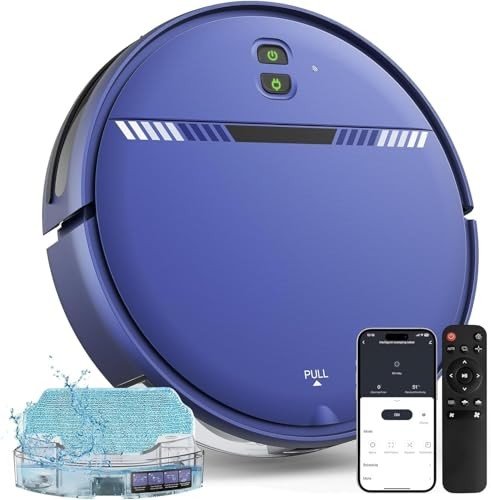Sage Advice About Vacuums Robot From The Age Of Five
The Rise of Robot Vacuums: A Comprehensive Guide
Over the last few years, robotic vacuum cleaners have transformed the way households preserve cleanliness. With Automatic Cleaning Machines becoming advanced and available, they have actually garnered attention for their performance, benefit, and features. This post explores what robotic vacuums offer, how they work, the advantages they offer, and the considerations buyers should bear in mind when picking one.
What Is a Robot Vacuum?
A robot vacuum is an automated, self-governing cleaning device designed to perform different cleaning jobs, typically concentrated on floor surfaces. They are equipped with sensors, brushes, and motors that enable them to browse around rooms, avoid barriers, and tidy efficiently. The advent of smart home innovation further boosts these devices' abilities, enabling users to integrate them into their home automation systems.
Types of Robot Vacuums
Robot vacuums come in different models, each with distinct features and performances. Here are a few of the primary types:
Basic Models:
- Simple cleaning functions
- Random navigation patterns
- Lower price point
Mid-Range Models:
- Improved navigation systems (e.g., gyroscopic or sensor-based)
- Scheduling capabilities
- Moderate suction power
High-End Models:
- Advanced mapping and navigation capabilities
- Smart functions (Wi-Fi connectivity, combination with smart assistants)
- High suction power and specialized brushes for different surfaces
Features to Consider
When selecting a robot vacuum, various functions can enhance user experience and general functionality. Below is a list of critical functions to think about:
Mapping Technology:
- Advanced designs map out spaces, permitting effective cleaning and room-specific settings.
Suction Power:
- Higher suction power can enhance efficiency on numerous surface areas, particularly carpets.
Battery Life:
- Longer battery life enables extended cleaning sessions. Try to find models that can go back to charging stations when short on power.
Dustbin Capacity:
- Consider the size of the dustbin as it determines how often it requires to be cleared.
Control Options:
- Many models provide mobile app combination and voice control compatibility. This permits remote operation and scheduling.
Challenge Detection:
- Advanced designs make use of cams and sensors to prevent obstacles and avoid getting stuck.
Mopping Capability:
- Some robot vacuums consist of mopping functionality, offering a two-in-one cleaning solution.
Benefits of Using a Robot Vacuum
Robot vacuums offer numerous significant advantages over conventional vacuums:
Convenience:
Users can set a cleaning schedule and let the vacuum do the work, maximizing important effort and time.Efficiency:
Many designs have intelligent navigation innovation that enables them to tidy systematically, guaranteeing no area is ignored.Availability:
Robot vacuums can reach under furnishings and other hard-to-reach locations, offering a more extensive cleaning experience.Irritant Reduction:
Regular vacuuming lowers dust, pet hair, and allergens, enhancing indoor air quality, particularly useful for allergic reaction victims.Programmable Cleaning:
Users can customize cleaning schedules based upon their way of life, making sure homes stay clean without manual intervention.
How Robot Vacuums Work
Understanding how a robot vacuum operates can assist users maximize its potential. Below is a simplified overview of the working mechanism:
Sensors:
Robot vacuums are equipped with many sensors to avoid crashes and browse around furnishings. Infrared and cliff sensing units prevent them from falling off stairs.Navigation and Mapping:
Basic models may use random navigation patterns, while sophisticated models use advanced mapping innovation to produce a design of the home. They can recognize areas that need specific attention, enhancing overall efficiency.Cleaning Mechanisms:
Robot vacuums use brushes or rollers to agitate dirt and particles, enabling the suction motor to gather the particles into a dustbin. best roborock vacuum include HEPA filters to trap irritants.Recharge Cycle:
When the battery runs low, the robot vacuum can return to its docking station autonomously to charge, guaranteeing it's always ready for its next cleaning session.
Popular Brands of Robot Vacuums
With a growing market for robotic vacuums, several brand names standout for their development, client service, and item performance. Below are a few of the leading brand names:
Brand
Noteworthy Features
Price Range
iRobot Roomba
Smart mapping, Wi-Fi connection, strong suction
₤ 200 – ₤ 1,000
Roborock
Laser mapping, mopping function, outstanding battery life
₤ 300 – ₤ 900
Ecovacs D-Bot
Smart home combination, powerful cleaning modes
₤ 250 – ₤ 600
Neato Robotics
D-shape design for corner cleaning, strong suction
₤ 400 – ₤ 800
Eufy
Affordable options, decent suction power
₤ 150 – ₤ 400
Often Asked Questions (FAQs)
Can robot vacuums replace traditional vacuums?
Robot vacuums can significantly lower the frequency of traditional vacuuming, but they may not entirely change them due to limitations on deep cleaning and bigger particles. Lots of people use both for ideal results.
How typically should a robot vacuum run?
A robot vacuum can be set up to tidy everyday or numerous times a week, depending on way of life, animal hair levels, and home foot traffic.
Are robot vacuums quiet?
Most robot vacuums are created to operate quietly, but sound levels may vary based upon the design and cleaning surface area.
How do I preserve my robot vacuum?
Routine upkeep consists of emptying the dustbin, cleaning the filters, and checking the brushes for hair and debris. Regularly, users may require to upgrade firmware.
Is it safe for animals?
The majority of robot vacuums are safe for pets, but guaranteeing that they don't get tangled with long hair is important. Features like challenge detection can help prevent mishaps.
Robot vacuums have emerged as a revolutionary cleaning service that streamlines household upkeep. With efficient cleaning paths, ease of usage, and advanced innovation, they can fit flawlessly into modern-day way of lives. When choosing a robotic vacuum, purchasers should think about numerous functions, types, and brand names to find the perfect fit for their home's cleaning requirements. As innovation continues to develop, it's most likely that the benefit and effectiveness of robotic vacuums will only enhance, making them a vital device in every household.
